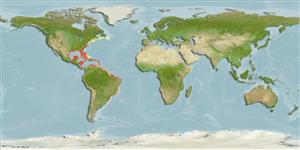Environment: milieu / Zona climática / intervalo de profundidade / distribution range
Ecologia
marinhas associadas(os) a recifes; intervalo de profundidade 1 - 50 m (Ref. 3790). Subtropical; 52°N - 34°S, 98°W - 34°W
Western Atlantic: Newfoundland (Canada), Bermuda, and northern Gulf of Mexico to Argentina, including the Caribbean (Ref. 3790). Eastern Atlantic.
Tamanho / Peso / Idade
Maturidade: Lm ? range ? - ? cm
Max length : 20.0 cm TL macho/indeterminado; (Ref. 7251); common length : 10.0 cm TL macho/indeterminado; (Ref. 3790)
Espinhos dorsais (total) : 2; Raios dorsais (total) : 29 - 37; Espinhos anais: 0; Raios anais : 28 - 36. Snout prominently projecting but not very elongate; first dorsal spine originating above posterior part of eye; adult males with two pairs of enlarged recurved spines on each side of caudal peduncle; spines of females only slightly larger than other scale spinules of caudal peduncle (Ref. 13442).
Body shape (shape guide): short and / or deep.
Occurs in shallow water down to 50 m depth, over sandy and rocky bottoms, but more commonly in grass beds (Ref. 3790). Often seen moving head down among seagrass blades (Ref. 9710). The young are often associated with floating Sargassum (Ref. 3720). Feeds on plants and algae, and also on small crustaceans (Ref. 3720). Rarely consumed (Ref. 3790).
Ciclo de vida ou comportamento de acasalamento
Maturidade | Reprodução | Desova | Ovos | Fecundidade | Larvas
Distinct pairing (Ref. 205).
Robins, C.R. and G.C. Ray, 1986. A field guide to Atlantic coast fishes of North America. Houghton Mifflin Company, Boston, U.S.A. 354 p. (Ref. 7251)
Status na Lista Vermelha da UICN (Ref. 130435: Version 2025-1)
Ameaça para os humanos
Reports of ciguatera poisoning (Ref. 30303)
Uso pelos humanos
Pescarias: pesca de subsistência; Aquário: Espécies comerciais
Ferramentas
Relatórios especiais
Baixar XML
Fontes da internet
Estimates based on models
Preferred temperature (Ref.
123201): 22.7 - 28, mean 25.6 °C (based on 440 cells).
Índice de diversidade filogenética (Ref.
82804): PD
50 = 0.6250 [Uniqueness, from 0.5 = low to 2.0 = high].
Bayesian length-weight: a=0.01349 (0.00885 - 0.02055), b=2.87 (2.74 - 3.00), in cm total length, based on LWR estimates for this species & (Sub)family-body (Ref.
93245).
Nível Trófico (Ref.
69278): 2.7 ±0.2 se; based on diet studies.
Resiliência (Ref.
120179): Elevada, tempo mínimo de duplicação da população menor que 15 meses (Preliminary K or Fecundity.).
Fishing Vulnerability (Ref.
59153): Low vulnerability (10 of 100).
🛈
Nutrients (Ref.
124155): Calcium = 35.8 [14.4, 118.8] mg/100g; Iron = 0.713 [0.328, 1.784] mg/100g; Protein = 18.6 [16.3, 20.8] %; Omega3 = 0.162 [0.073, 0.328] g/100g; Selenium = 15.5 [6.4, 37.2] μg/100g; VitaminA = 38.6 [9.1, 169.8] μg/100g; Zinc = 0.952 [0.572, 1.628] mg/100g (wet weight);
